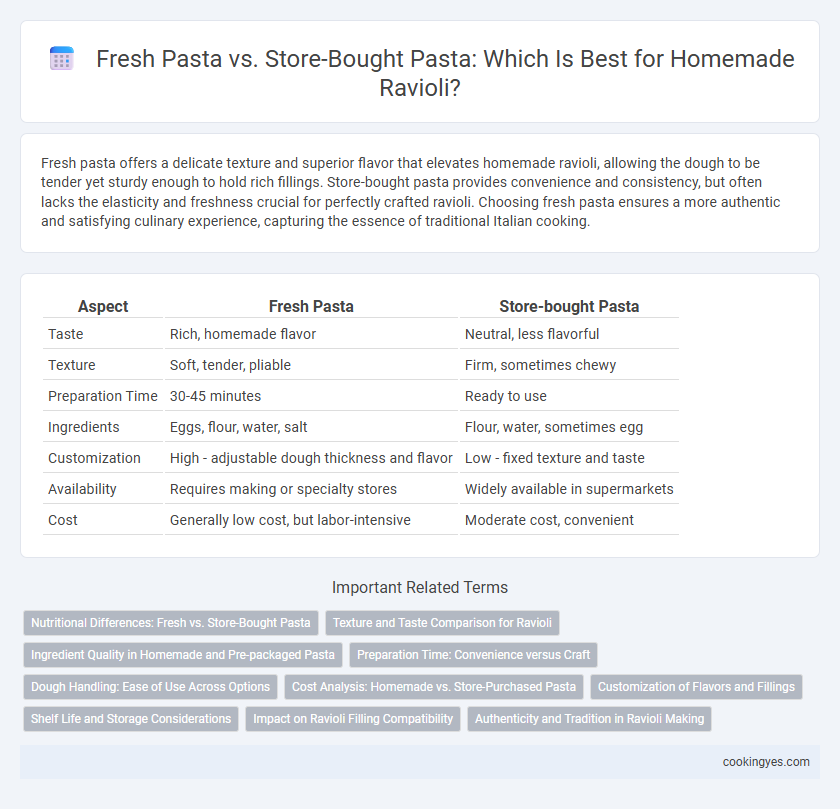Fresh pasta offers a delicate texture and superior flavor that elevates homemade ravioli, allowing the dough to be tender yet sturdy enough to hold rich fillings. Store-bought pasta provides convenience and consistency, but often lacks the elasticity and freshness crucial for perfectly crafted ravioli. Choosing fresh pasta ensures a more authentic and satisfying culinary experience, capturing the essence of traditional Italian cooking.
Table of Comparison
| Aspect | Fresh Pasta | Store-bought Pasta |
|---|---|---|
| Taste | Rich, homemade flavor | Neutral, less flavorful |
| Texture | Soft, tender, pliable | Firm, sometimes chewy |
| Preparation Time | 30-45 minutes | Ready to use |
| Ingredients | Eggs, flour, water, salt | Flour, water, sometimes egg |
| Customization | High - adjustable dough thickness and flavor | Low - fixed texture and taste |
| Availability | Requires making or specialty stores | Widely available in supermarkets |
| Cost | Generally low cost, but labor-intensive | Moderate cost, convenient |
Nutritional Differences: Fresh vs. Store-Bought Pasta
Fresh pasta for ravioli typically contains fewer preservatives and additives compared to store-bought varieties, resulting in a product with higher nutrient retention, including vitamins B and E. Store-bought pasta often undergoes processing that reduces its natural fiber and protein content, while fresh pasta maintains a richer amino acid profile due to its simple, whole ingredients like eggs and flour. Choosing fresh pasta can contribute to a more nutrient-dense meal, supporting better digestion and sustained energy release.
Texture and Taste Comparison for Ravioli
Fresh pasta for ravioli offers a tender, silky texture that melts in the mouth, enhancing the delicate fillings with its subtle wheat flavor. Store-bought pasta tends to be denser and firmer, providing a chewier bite that can sometimes overpower lighter fillings. The taste of fresh pasta is more nuanced and aromatic, while store-bought varieties often contain preservatives that slightly alter the flavor profile.
Ingredient Quality in Homemade and Pre-packaged Pasta
Fresh pasta for ravioli typically uses high-quality ingredients like organic eggs and fine durum wheat flour, resulting in a tender texture and richer flavor. Store-bought pasta often contains preservatives and lower-grade flour, which can affect the dough's elasticity and overall taste. Homemade pasta allows precise control over ingredient freshness and composition, enhancing the ravioli's culinary authenticity.
Preparation Time: Convenience versus Craft
Fresh pasta dough requires more preparation time, including kneading and resting, which enhances the texture and flavor of ravioli. Store-bought pasta offers convenience with immediate use but may lack the delicate softness and elasticity of freshly made dough. Choosing fresh pasta elevates the craft of ravioli making, while store-bought pasta suits quick and easy meal preparation.
Dough Handling: Ease of Use Across Options
Fresh pasta dough for ravioli offers superior pliability and elasticity, making it easier to shape and seal without cracking, which enhances the overall texture of the final dish. Store-bought pasta, while convenient, often lacks the same flexibility and may require additional moisture or careful handling to prevent breaking during filling and folding. Mastering dough handling with fresh pasta typically results in more consistent ravioli, as the elasticity supports a tighter seal and a tender bite.
Cost Analysis: Homemade vs. Store-Purchased Pasta
Homemade fresh pasta for ravioli typically involves higher upfront costs due to ingredients such as premium flour, eggs, and time investment, yet it provides superior texture and customizable thickness. Store-bought pasta offers convenience and lower immediate expenses, often costing less per serving but sacrificing freshness and flavor complexity. Considering long-term value, homemade pasta can reduce costs when made in larger batches, whereas store-bought pasta remains a budget-friendly option for quick meal preparation.
Customization of Flavors and Fillings
Fresh pasta for ravioli making offers unparalleled customization of flavors and fillings, allowing chefs to incorporate unique herbs, spices, and ingredients directly into the dough and stuffing. Store-bought pasta, while convenient, typically provides limited options and often lacks the flexibility to tailor textures or flavors to personal preference. Using fresh pasta enhances the overall taste experience by enabling creative combinations that are difficult to achieve with pre-packaged alternatives.
Shelf Life and Storage Considerations
Fresh pasta for ravioli offers a tender texture but has a significantly shorter shelf life, typically lasting only 1 to 2 days when refrigerated, requiring prompt use or freezing to extend freshness. Store-bought pasta, on the other hand, boasts a longer shelf life due to drying and packaging techniques, often remaining usable for several months at room temperature. Proper storage of fresh pasta involves airtight containers and refrigeration, while dried store-bought ravioli should be stored in a cool, dry place to maintain optimal quality and prevent spoilage.
Impact on Ravioli Filling Compatibility
Fresh pasta for ravioli offers a tender texture that complements delicate fillings such as ricotta, spinach, or seafood, enhancing the overall flavor balance. Store-bought pasta tends to be firmer and denser, which can overpower softer fillings and may require heartier ingredients like meat or robust cheese blends. Choosing fresh pasta improves dough elasticity and sealing, minimizing filling leakage and maintaining the ravioli's structural integrity during cooking.
Authenticity and Tradition in Ravioli Making
Fresh pasta dough, crafted from simple ingredients like flour, eggs, and water, preserves the authentic texture and delicate flavor essential to traditional ravioli making. Store-bought pasta often contains preservatives and stabilizers that alter the dough's elasticity and subtle taste, impacting the genuine culinary experience. Hand-rolled fresh pasta upholds the heritage of ravioli, ensuring tender, thin sheets that complement rich fillings and honor classic Italian craftsmanship.
Fresh pasta vs Store-bought pasta for ravioli making Infographic

 cookingyes.com
cookingyes.com